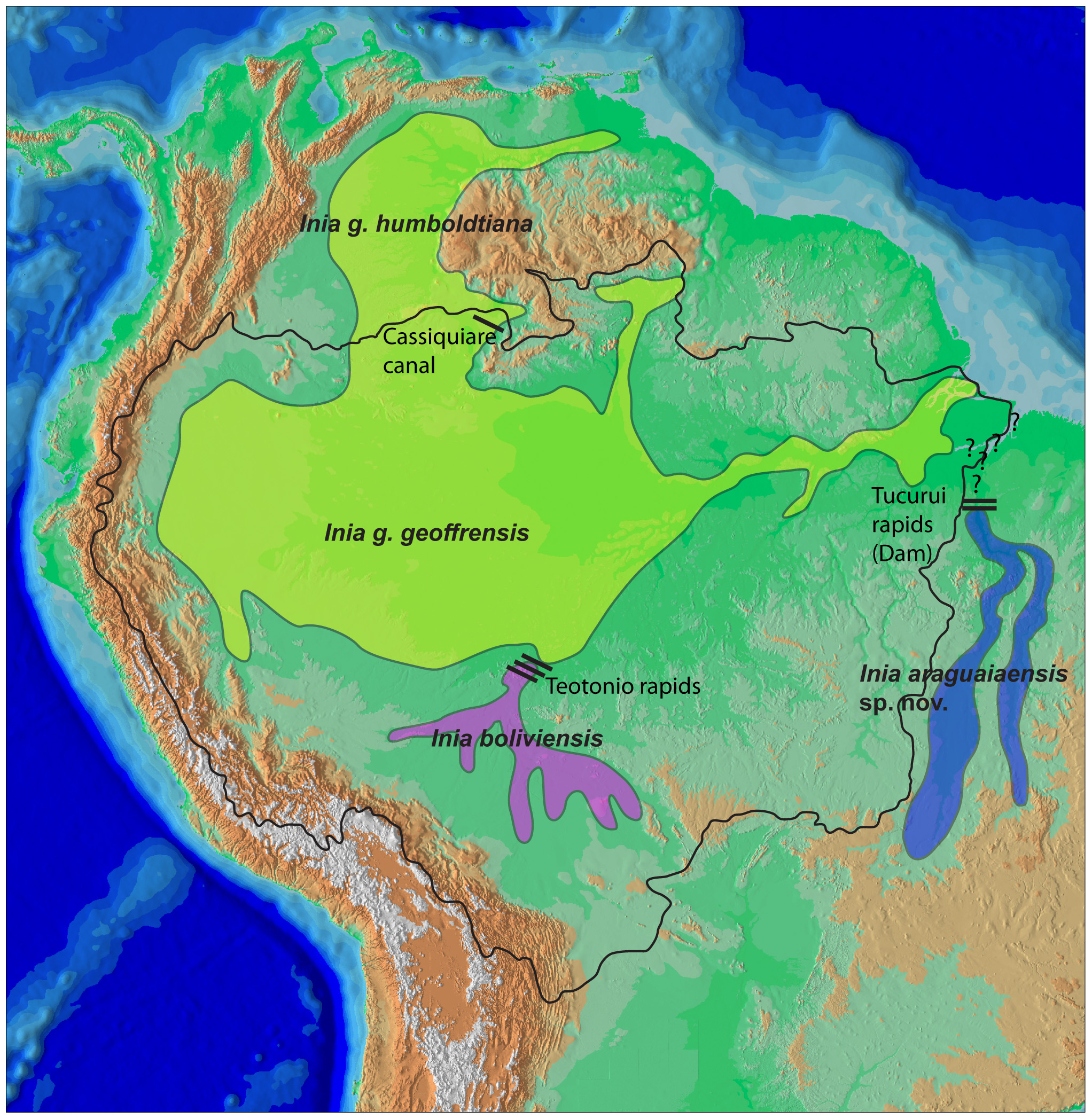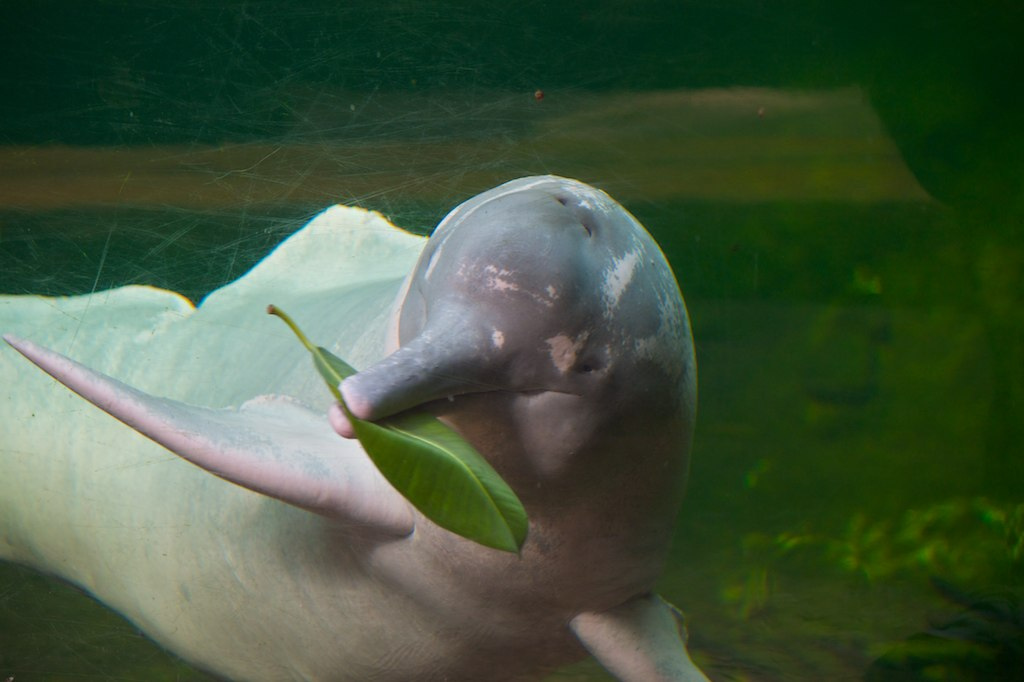|
River Dolphin
River dolphins are a polyphyletic group of fully aquatic mammals that reside exclusively in freshwater or brackish water. They are an informal grouping of dolphins, which itself is a paraphyletic group within the infraorder Cetacea. Extant river dolphins are placed in two superfamilies, Platanistoidea and Inioidea. They comprise the families Platanistidae (the South Asian dolphins), the recently extinct Lipotidae (Yangtze river dolphin), Iniidae (the Amazonian dolphins) and Pontoporiidae. There are five extant species of river dolphins. River dolphins, alongside other cetaceans, belong to the clade Artiodactyla, with even-toed ungulates, and their closest living relatives the hippopotamuses, from which they diverged about 40 million years ago. Specific types of Dolphins can be pink. River dolphins are relatively small compared to other dolphins, having evolved to survive in warm, shallow water and strong river currents. They range in size from the long South Asian river do ... [...More Info...] [...Related Items...] OR: [Wikipedia] [Google] [Baidu] |
Ganges River Dolphin
The Ganges river dolphin (''Platanista gangetica'') is a species of toothed whale classified in the family Platanistidae. It lives in the Ganges and related rivers of South Asia, namely in the countries of India, Nepal, and Bangladesh. It is related to the much smaller Indus river dolphin which lives in the Indus River in Pakistan and the Beas River of northwestern India. It is also known by the name ''susu'' (popular name) or "Sisu" (Assamese language) and ''shushuk'' (Bengali)., page 451 etter Aand page 568 etter S The Ganges river dolphin has been recognized by the government of India as its National Aquatic Animal and is the official animal of the Indian city of Guwahati. Its first occurrence, within the Hooghly River, was documented bWilliam Roxburgh Taxonomy The Ganges river dolphin split from the Indus river dolphin during the Pleistocene, around 550,000 years ago. This species and the Indus river dolphin, were initially classified as a single species, ''Platanista gan ... [...More Info...] [...Related Items...] OR: [Wikipedia] [Google] [Baidu] |
Baiji
The baiji (; IPA: ; ''Lipotes vexillifer'', ''Lipotes'' meaning "left behind" and ''vexillifer'' "flag bearer") is a possibly extinct species of freshwater dolphin native to the Yangtze river system in China. It is thought to be the first dolphin species driven to extinction due to the impact of humans. This dolphin is listed as “critically endangered: possibly extinct” by the IUCN, has not been seen in 20 years, and several surveys of the Yangtze have failed to find it. In China, the species is also called the Chinese river dolphin, Yangtze river dolphin, Yangtze dolphin and whitefin dolphin. Nicknamed the "Goddess of the Yangtze" (), it was regarded as the goddess of protection by local fishermen and boatmen. It is not to be confused with the Chinese white dolphin (''Sousa chinensis'') or the finless porpoise (''Neophocaena phocaenoides''). The baiji population declined drastically in decades as China industrialized and made heavy use of the river for fishing, transportati ... [...More Info...] [...Related Items...] OR: [Wikipedia] [Google] [Baidu] |
Aquatic Mammal
Aquatic and semiaquatic mammals are a diverse group of mammals that dwell partly or entirely in bodies of water. They include the various marine mammals who dwell in oceans, as well as various freshwater species, such as the European otter. They are not a taxon and are not unified by any distinct biological grouping, but rather their dependence on and integral relation to aquatic ecosystems. The level of dependence on aquatic life varies greatly among species. Among freshwater taxa, the Amazonian manatee and river dolphins are completely aquatic and fully dependent on aquatic ecosystems. Semiaquatic freshwater taxa include the Baikal seal, which feeds underwater but rests, molts, and breeds on land; and the capybara and hippopotamus which are able to venture in and out of water in search of food. Mammal adaptation to an aquatic lifestyle vary considerably between species. River dolphins and manatees are both fully aquatic and therefore are completely tethered to a life in the wat ... [...More Info...] [...Related Items...] OR: [Wikipedia] [Google] [Baidu] |
South Asian River Dolphin
South Asian river dolphins are toothed whales in the genus ''Platanista'', which inhabit fresh water habitats in the northern Indian subcontinent. They were historically considered to be one species (''P. gangetica'') with the Ganges river dolphin and the Indus river dolphin being subspecies (''P. g. gangetica'' and ''P. g. minor'' respectively). Genetic and morphological evidence in 2021 has shown them to be separate species. The Ganges and Indus river dolphins are estimated to have diverged 550,000 years ago. They are the only living members of the family Platanistidae and the superfamily Platanistoidea. Fossils of ancient relatives date to the late Oligocene. South Asian river dolphins are small but stocky cetaceans with long snouts or rostra, broad flippers, and small dorsal fins. They have several unusual features. Living in murky river waters, their eyes are tiny and lensless, relying instead on echolocation for navigation. The skull has large crests over the melon, ... [...More Info...] [...Related Items...] OR: [Wikipedia] [Google] [Baidu] |
Cetacea
Cetacea (; , ) is an infraorder of aquatic mammals that includes whales, dolphins, and porpoises. Key characteristics are their fully aquatic lifestyle, streamlined body shape, often large size and exclusively carnivorous diet. They propel themselves through the water with powerful up-and-down movement of their tail which ends in a paddle-like fluke, using their flipper-shaped forelimbs to maneuver. While the majority of cetaceans live in marine environments, a small number exclusively reside in brackish water or fresh water. Having a cosmopolitan distribution, they can be found in some rivers and all of Earth's oceans, and many species inhabit vast ranges where they migrate with the changing of the seasons. Cetaceans are famous for their high intelligence and complex social behaviour as well as for the enormous size of some of the group's members, such as the blue whale which reaches a maximum confirmed length of 29.9 meters (98 feet) and a weight of 173 tonnes (190 short t ... [...More Info...] [...Related Items...] OR: [Wikipedia] [Google] [Baidu] |
Indus River Dolphin
The Indus river dolphin (''Platanista minor''), also known as the ''bhulan'' in Urdu and Sindhi, is a species of toothed whale in the family Platanistidae. It is endemic to the Indus River Basin of Pakistan and northwestern India. This dolphin was the first discovered side-swimming cetacean. It is patchily distributed in five small, sub-populations that are separated by irrigation barrages. From the 1970s until 1998, the Ganges River dolphin (''Platanista gangetica'') and the Indus dolphin were regarded as separate species; however, in 1998, their classification was changed from two separate species to subspecies of a single species. However, more recent studies support them being distinct species. It has been named as the national mammal of Pakistan, and the state aquatic animal of Punjab, India. Taxonomy The Ganges river dolphin split from the Indus river dolphin during the Pleistocene, around 550,000 years ago. This species and the Indus river dolphin, were initiall ... [...More Info...] [...Related Items...] OR: [Wikipedia] [Google] [Baidu] |
Arktocara NT Small
''Arktocara'' is an extinct genus of river dolphin from the Oligocene epoch of Alaska, containing one species, ''A. yakataga''. Having been discovered in 25-million-year-old strata near the 60th parallel north, it is perhaps the oldest-known crown toothed whale and the northmost river dolphin discovered. It was a member of the now-extinct family Allodelphinidae, along with the genera '' Allodelphis'', '' Goedertius'', '' Ninjadelphis'', and '' Zarhinocetus''. It measured approximately , comparable to its closest living relative, the South Asian river dolphin, which measures . However, the animal probably had an elongated beak and neck, so it may have been longer. The animal is known only from a partially preserved skull. Its ecology may have been similar to the modern-day Dall's porpoise, and it may have competed with contemporaneous delphinoids. Its remains were found in the Poul Creek Formation, which has also yielded several mollusk species. Taxonomy The type speci ... [...More Info...] [...Related Items...] OR: [Wikipedia] [Google] [Baidu] |
Functionally Extinct
Functional extinction is the extinction of a species or other taxon such that: #It disappears from the fossil record, or historic reports of its existence cease; #The reduced population no longer plays a significant role in ecosystem function; or #The population is no longer viable. There are no individuals able to reproduce, or the small population of breeding individuals will not be able to sustain itself due to inbreeding depression and genetic drift, which leads to a loss of fitness. In plant populations, self-incompatibility mechanisms may cause related plant specimens to be incompatible, which may lead to functional extinction if an entire population becomes self-incompatible. This does not occur in larger populations. In polygynous populations, where only a few males leave offspring, there is a much smaller reproducing population than if all viable males were considered. Furthermore, the successful males act as a genetic bottleneck, leading to more rapid genetic drift o ... [...More Info...] [...Related Items...] OR: [Wikipedia] [Google] [Baidu] |
Society For Marine Mammalogy
The Society for Marine Mammalogy was founded in 1981 and is the largest international association of marine mammal scientists in the world. Mission The mission of the Society for Marine Mammalogy (SMM) is to promote the global advancement of marine mammal science and contribute to its relevance and impact in education, conservation and management. Objectives * Evaluate and promote the educational, scientific and managerial advancement of marine mammal science. * Gather and disseminate to members of the Society, the public, and public and private institutions, scientific, technical and management information through publications and meetings. * Provide scientific information, as required, on matters related to the conservation and management of marine mammal resources. History The Biennial Conferences on the Biology of Marine Mammals predate the founding of the Society. The Biennial Conferences were a successor to Tom Poulter's "Annual Conference on Biological Sonar and Diving M ... [...More Info...] [...Related Items...] OR: [Wikipedia] [Google] [Baidu] |
Family (biology)
Family ( la, familia, plural ') is one of the eight major hierarchical taxonomic ranks in Linnaean taxonomy. It is classified between order and genus. A family may be divided into subfamilies, which are intermediate ranks between the ranks of family and genus. The official family names are Latin in origin; however, popular names are often used: for example, walnut trees and hickory trees belong to the family Juglandaceae, but that family is commonly referred to as the "walnut family". What belongs to a family—or if a described family should be recognized at all—are proposed and determined by practicing taxonomists. There are no hard rules for describing or recognizing a family, but in plants, they can be characterized on the basis of both vegetative and reproductive features of plant species. Taxonomists often take different positions about descriptions, and there may be no broad consensus across the scientific community for some time. The publishing of new data and opi ... [...More Info...] [...Related Items...] OR: [Wikipedia] [Google] [Baidu] |
Habitat Destruction
Habitat destruction (also termed habitat loss and habitat reduction) is the process by which a natural habitat becomes incapable of supporting its native species. The organisms that previously inhabited the site are displaced or dead, thereby reducing biodiversity and species abundance. Habitat destruction is the leading cause of biodiversity loss. Fragmentation and loss of habitat have become one of the most important topics of research in ecology as they are major threats to the survival of endangered species. Activities such as harvesting natural resources, industrial production and urbanization are human contributions to habitat destruction. Pressure from agriculture is the principal human cause. Some others include mining, logging, trawling, and urban sprawl. Habitat destruction is currently considered the primary cause of species extinction worldwide. Environmental factors can contribute to habitat destruction more indirectly. Geological processes, climate chan ... [...More Info...] [...Related Items...] OR: [Wikipedia] [Google] [Baidu] |







